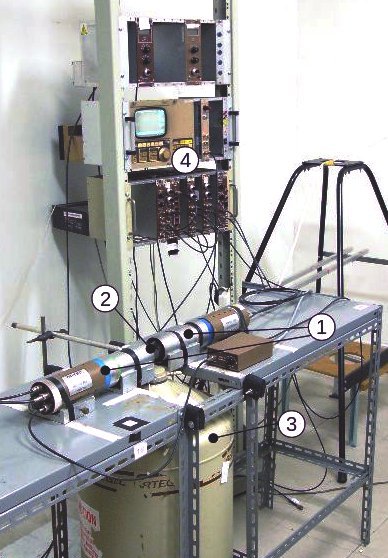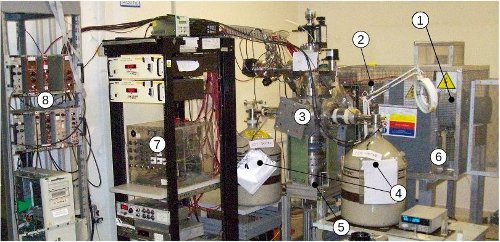Positron spectrometers
Fast positron spectrometers

Positron lifetime spectrometer. Parts: 1. Scintillators and photomultipliers; 2. Sample; 3. Liquid nitrogen Dewar; 4. Detector electronics.
Fast positrons are obtained by the radioactive decay of a 22Na sealed radioactive source sandwiched between two identical samples. Positrons are emitted from the source with an high energy (22Na has a positron endpoint energy of 540 keV) and sampled several hundred microns from the surface of the specimen.
Our laboratory is equipped with two analog gamma ray spectrometers for PL measurements with a time resolution of about 240 ps. The gamma spectrometers are fast scintillators (BaF and plastic scintillators) coupled with photomultipliers. DBS is performed by means of two HpGe detectors with an energy resolution of about 1.2 keV on the annihilation line. The two detectors are coupled with a multi-parametric pulse analyzer which allows for coincidence measurements at a very high signal to noise ratio. Samples can be measured at room temperature or at liquid nitrogen temperature. High vacuum measurements can also be performed.
Slow positron spectrometers

Slow positron beam. Parts: 1. Radioactive source; 2. Electrostatic optics; 3. Sample chamber; 4. HpGe detectors; 5. Cryostat; 6. High voltage protection cage; 7. Power suppliers; 8. Detector electronics.
Slow positron measurements are performed by moderating positrons emitted by an 50 mCi sealed radioactive source and then implanting them into the sample with a kinetic energy ranging from few eV to 20 keV. The positron implantation depth is a few microns, depending on the sample density.
The positron beam is equipped with HpGe detectors for momentum distribution measurements, which can be operated in both single and coincidence mode. Samples are kept in high vacuum (~10-9 mbar) and their temperature can be varied from 10 to 1000 K. The slow positron beam has been calibrated for positronium fraction measurements.
Useful links
- Positronannihilation.net for a brief but exhaustive tutorial on positron techniques.
Copyright © 2010 L-NESS Como
